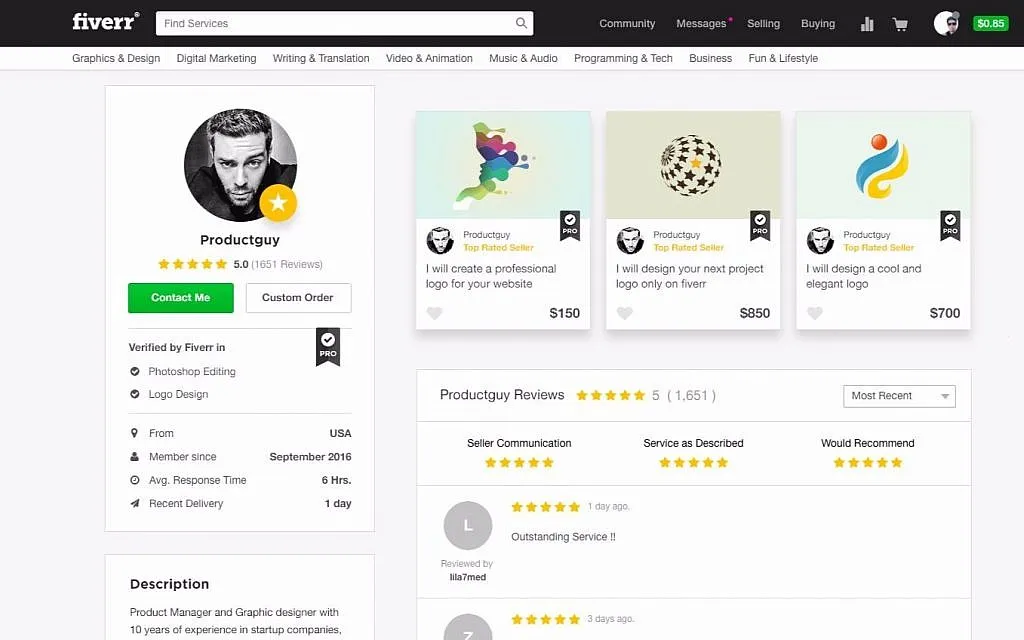Fiverr is a name that resonates with freelancers and entrepreneurs around the globe. But have you ever wondered how this revolutionary platform came to be? In this post, we'll take you on a journey through time, exploring the origins of Fiverr and how it transformed the freelance marketplace. From its inception to the thriving community it is today, we’ll delve into the story behind the brand, the visionaries who drove its creation, and the challenges they faced along the way. Grab a cup of coffee and let's get started!
The Origins of Fiverr

The story of Fiverr began in 2010 when co-founders Micha Kaufman and Shai Wininger identified a simple yet impactful idea: to connect freelancers with clients looking for affordable services. The name "Fiverr" itself is derived from the original concept that every service listed on the platform would start at just $5. This made the site appealing to both freelancers looking to make extra income and clients seeking budget-friendly solutions.
Before Fiverr, freelancers often relied on traditional job boards, which could be restrictive and inefficient. Kaufman and Wininger recognized the need for a platform that democratized access to freelance work, allowing anyone with a skill to offer their services without the barriers typically associated with freelancing.
| Year | Milestone |
|---|---|
| 2010 | Fiverr is launched. |
| 2012 | Reached 1 million services (gigs) offered on the platform. |
| 2014 | Introduced the Fiverr Pro section for high-quality services. |
| 2019 | Went public on the New York Stock Exchange. |
With a user-friendly interface and a vast array of services, Fiverr quickly gained traction. From graphic design and digital marketing to writing and translation services, the platform provided a virtual marketplace where talent could shine. This innovative approach not only shaped the future of freelance work but also set the stage for a new generation of entrepreneurs. Fiverr's journey from a simple idea to a booming marketplace demonstrates the power of vision, creativity, and adaptability in the tech-driven world.
Also Read This: How Long Does It Take to Become a Top Rated Seller on Fiverr?
The Vision Behind Fiverr

The inception of Fiverr was driven by a compelling vision: to create a marketplace that democratizes the freelance economy. Founded in 2010 by Micha Kaufman and Shai Wininger, the duo recognized that traditional freelance job platforms were often cumbersome and inaccessible for many. They believed that by providing a simple, user-friendly interface, they could empower individuals to leverage their skills and talents in an unprecedented way.
At the heart of Fiverr's vision was the concept of breaking down barriers. They aimed to create an environment where services could be offered for as little as $5, giving entrepreneurs, creatives, and professionals a platform to reach a global audience. This was revolutionary, as it not only catered to a diverse range of freelancers but also allowed businesses of all sizes to access quality services without breaking the bank.
Moreover, Fiverr was designed with inclusivity in mind, fostering a community where anyone, regardless of experience or background, could offer their skills. This commitment to accessibility means that on Fiverr, you can find everything from graphic design and writing to voiceovers and programming.
The vision extended beyond just a platform; it was about creating opportunities. Fiverr sought to empower freelancers by giving them control over their work, allowing them to set their prices, choose projects that excite them, and maintain a flexible work schedule. This idea resonates strongly to this day, making Fiverr not just a marketplace, but a community where creativity thrives.
Also Read This: Top 10 UI/UX Designers on Fiverr in 2024
Key Milestones in Fiverr's Development

Fiverr's journey has been marked by several key milestones that propelled it from a budding startup to a formidable player in the freelance marketplace. Here’s a look at some pivotal moments:
| Year | Milestone |
|---|---|
| 2010 | Launch of Fiverr – Introduced the $5 service model. |
| 2012 | Expansion of service categories – Added diverse categories ranging from tech to digital marketing. |
| 2014 | Introduction of Gig Extras – Allowed sellers to offer add-ons, increasing potential earnings. |
| 2019 | Fiverr’s IPO – The company went public, highlighting its growth and popularity in the freelance market. |
| 2021 | Launch of Fiverr Workspace – A new tool designed to help freelancers manage projects more effectively. |
Each of these milestones reflects Fiverr's commitment to innovation and enhancement, consistently evolving to meet the needs of both freelancers and buyers. Whether it’s expanding the range of services offered or improving user experience, Fiverr has been dedicated to creating a thriving ecosystem for freelancers worldwide.
Today, Fiverr stands as a testament to the power of vision and innovation in creating opportunities for millions of freelancers and businesses alike!
Also Read This: How to Always Be Online on Fiverr
The Impact of Technology on Fiverr's Growth
When we dive into the story of Fiverr, one of the most significant factors that contributed to its rise is undoubtedly technology. It’s fascinating how the evolution of tech has shaped not just Fiverr, but the entire freelance landscape.
Fiverr launched in 2010, right around the time when technology was making significant leaps. High-speed internet, the proliferation of smartphones, and the rise of social media platforms created an environment ripe for innovation. Here’s how technology has played a pivotal role in Fiverr’s success:
- Accessibility: Thanks to the internet, anyone with a computer or smartphone can access Fiverr’s platform from anywhere in the world. This broad accessibility has allowed a diverse pool of freelancers to showcase their skills and reach clients without geographical limitations.
- User-Friendly Interface: Fiverr’s interface is designed to be intuitive. The streamlined user experience makes it easy for clients to browse services and for freelancers to create profiles. Technology has made this process seamless and efficient.
- Automated Payments: The integration of secure payment systems has alleviated concerns about trust and reliability. Freelancers can confidently offer their services, knowing that payment will be handled safely and efficiently.
- Data Analytics: Collecting and analyzing user data has allowed Fiverr to tailor its offerings based on demand, optimize its services, and even provide insightful trends to its users.
In essence, technology has not merely influenced Fiverr’s growth; it has been the backbone of its entire operation, allowing both freelancers and clients to thrive in this digital marketplace.
Also Read This: How to Create a Gig on the Fiverr App
Challenges Faced by Fiverr in Its Early Days
Every success story comes with its fair share of challenges, and Fiverr is no exception. In its early days, the platform faced several hurdles that could have easily derailed its journey. Here’s a closer look at some of those challenges:
| Challenge | Impact |
|---|---|
| Building Trust: | As a new marketplace, Fiverr needed to convince users to trust the platform. Many potential clients were hesitant to hire freelancers online due to fears of scams or subpar work. |
| Quality Control: | Maintaining high standards was crucial. With a vast number of freelancers offering services, ensuring quality became a challenge, and negative reviews could tarnish its reputation. |
| Market Saturation: | Competing with established platforms and freelancers across various price ranges made it hard for Fiverr to carve out a niche. |
| Payment Processing Issues: | Initial technical glitches in payment processing created friction for users, leading to delays that fueled frustration and distrust. |
| Scalability: | As demand grew rapidly, scaling the platform's infrastructure to handle increased traffic without performance dips was a significant concern. |
Through adaptability and perseverance, Fiverr managed to navigate these obstacles, eventually establishing itself as a leading freelance marketplace. Every challenge became a learning opportunity, shaping the platform's future and ensuring it grew stronger over the years.
Also Read This: Can I Use Amazon Product Links on Fiverr?
How Fiverr Revolutionized Freelancing
Fiverr transformed the freelancing landscape, and here's how it did it. Before Fiverr, freelancing often came with a host of challenges, like finding reliable clients, handling payments, and dealing with endless negotiations. Fiverr tackled these pain points head-on by creating a streamlined platform that made freelancing accessible to everyone.
Here are some key aspects of how Fiverr revolutionized the industry:
- Microwork Model: Fiverr popularized the idea of "gigs"—small, well-defined tasks that were priced starting at just $5. This allowed freelancers to showcase specific skills, while clients could easily find the services they needed without sifting through lengthy proposals.
- Global Reach: By connecting freelancers and clients across geographical boundaries, Fiverr opened the doors to a vast, diverse marketplace. Anyone could sell their services to a global audience, breaking down traditional barriers.
- Simplified Transactions: With an integrated payment system, Fiverr took the hassle out of financial transactions. Clients pay upfront, ensuring that freelancers get paid promptly after delivery.
- User-Friendly Interface: Fiverr's intuitive design makes it easy for both freelancers and clients to navigate the platform. Users can create profiles, upload portfolios, and explore services with minimal effort.
- Community and Support: Fiverr fosters a strong community of freelancers and buyers, providing resources, support, and reviews to help users succeed.
Thanks to these innovations, Fiverr not only changed how freelancers work but also demonstrated the potential of a digital-first economy. What began as a simple idea has now become a cornerstone of the gig economy!
Also Read This: How Can I Get My Money Back From Fiverr?
Fiverr Today: The Evolution of the Platform
Fast forward to today, and Fiverr has grown tremendously since its humble beginnings. It’s no longer just a platform for inexpensive gigs; it encompasses a wide range of services and has become a vital resource for both freelancers and businesses.
Here’s a close look at how Fiverr has evolved:
- Diverse Service Categories: Fiverr now offers an expansive array of categories, from graphic design and digital marketing to programming and writing. The platform has successfully diversified to cater to the evolving needs of clients.
- Fiverr Pro: Launched to provide clients with premium services, Fiverr Pro allows freelancers to showcase higher-quality work. This special designation ensures that businesses can find vetted professionals with proven expertise.
- Fiverr Business: Catering to companies, this feature streamlines collaboration for teams, allowing them to manage projects and work with multiple freelancers in an organized way.
- Enhanced User Experience: With user interface improvements and new features like personalized recommendations and advanced filtering, Fiverr continues to refine how users interact with the platform.
- Community Growth: The Fiverr community has matured, offering forums, resources, and client education programs, which further enrich the user experience.
Today, Fiverr stands as a powerful marketplace, constantly adapting to the changing dynamics of work and entrepreneurship. With millions of users worldwide, it plays an integral role in how we think about freelancing and collaboration in the modern age.
How Did Fiverr Start? An Insider's Look at the Journey of a Freelance Marketplace
Fiverr, a globally recognized freelance marketplace, has transformed the way people find and offer services. Founded in 2010 by Micha Kaufman and Shai Wininger, Fiverr emerged from a simple yet profound idea: to allow freelancers to offer services starting at just $5. This innovative approach redefined the gig economy and opened doors for countless freelancers worldwide.
Initially, Fiverr faced several challenges, including competition from established platforms and skepticism about the quality of $5 services. However, the founders were undeterred. They employed a marketing strategy that utilized social media platforms and partnerships to drive traffic to their site. The early stages of Fiverr were characterized by rapid growth, as the platform appealed to both budget-conscious consumers and freelancers looking for flexible work opportunities.
Key milestones in Fiverr's journey include:
- Launch Year (2010): Introduced the concept of micro-services, allowing users to offer or hire services for $5.
- Funding Rounds: Raised funds in multiple rounds, which helped scale operations and enhance platform features.
- Service Expansion: From 2012 onwards, Fiverr expanded its offerings beyond $5, introducing different levels and premium packages.
- Mobile App Launch (2014): The mobile application enabled users to access services on the go, catering to a broader audience.
- Going Public (2019): Fiverr became a publicly traded company, further solidifying its position in the freelance marketplace.
Today, Fiverr acts as a bridge between millions of freelancers and businesses, enabling them to connect over various services including graphic design, writing, programming, and marketing.
Conclusion: What the Future Holds for Fiverr
As Fiverr continues to innovate and adapt to the shifting dynamics of the freelance economy, its future seems promising, with advancements in AI and remote work trends likely shaping new opportunities for both freelancers and businesses.



